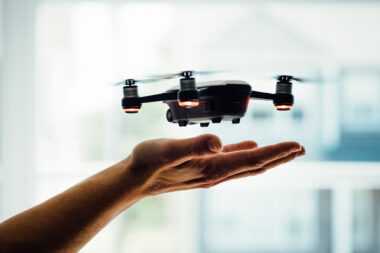Introduction
UAV, which stands for Unmanned Aerial Vehicle, refers to aircraft that operate without a human pilot on board. UAV technology in defence, commonly known as military drones, has become an integral part of modern military operations. Here are key aspects of UAV technology in defence:
- Surveillance and Reconnaissance:
- UAVs are extensively used for surveillance and reconnaissance missions. Equipped with cameras, sensors, and other imaging technologies, military drones can gather real-time intelligence, monitor enemy activities, and provide critical situational awareness to military commanders.
- Target Acquisition:
- Military drones are employed for target acquisition, helping to identify and track potential threats on the ground or at sea. High-resolution cameras and advanced sensors allow for precise target identification, enhancing the accuracy of military operations.
- Strategic and tactical operations:
- UAVs play a vital role in both strategic and tactical military operations. They can be used for strategic surveillance of large areas as well as for tactical support in specific missions, providing a versatile tool for military commanders.
- Communication Relay:
- Some UAVs are equipped with communication relay capabilities, serving as mobile communication hubs in areas where traditional communication infrastructure is limited or compromised. This is particularly valuable for maintaining connectivity in remote or hostile environments.
- Electronic Warfare:
- Certain military drones are designed for electronic warfare, including disrupting enemy communication systems, jamming radar signals, or collecting electronic intelligence. These capabilities contribute to the overall electronic warfare strategy of military forces.
- Search and Rescue:
- UAVs are employed in search and rescue operations to locate and identify individuals in disaster stricken or hard to reach areas. Equipped with thermal imaging and other sensors, they can aid in identifying survivors or assessing the extent of damage.
- Strategic Strikes:
- Armed UAVs, commonly known as drones with strike capabilities, are used for targeted strikes against enemy assets. These drones can carry precision guided munitions and provide a means to conduct surgical and precise airstrikes while minimizing collateral damage.
- Autonomous and Semi Autonomous Systems:
- Advances in UAV technology include the development of autonomous and semi-autonomous systems. These systems can operate with minimal human intervention, performing tasks such as waypoint navigation, obstacle avoidance, and mission planning.
- Stealth and Low Observable Design:
- Some military UAVs are designed with stealth features, making them less observable by enemy radar systems. This enhances their ability to operate covertly and avoid detection.
- Global Deploy ability:
- Military drones provide the flexibility to be deployed globally, offering rapid response capabilities and reducing the need to put human pilots in potentially dangerous situations.
Technology
1. Airframe:
- Fixed Wing: These UAVs have fixed wings, similar to traditional airplanes. They offer longer endurance and range, making them suitable for surveillance and reconnaissance.
- Rotary Wing (Multirotor): Quadcopters and other multirotor UAVs are highly manoeuvrable and can hover in place. They are commonly used for short range missions and tasks that require precise positioning.
2. Propulsion:
- Internal Combustion Engines: Many UAVs use traditional internal combustion engines for propulsion, especially in fixed wing aircraft.
- Electric Motors: Electric propulsion systems, powered by batteries, are common in smaller UAVs and multirotor. They offer quieter operation and are environmentally friendly.
3. Power Source:
- Battery Technology: Lithium-polymer (LiPo) and lithium-ion (Li-ion) batteries are widely used for electric UAVs. Advances in battery technology contribute to longer flight times and increased payload capacity.
4. Autonomous Navigation:
- GPS Navigation: UAVs often rely on GPS for navigation, providing accurate positioning information. In addition to GPS, inertial navigation systems may be used for precise control.
- Waypoint Navigation: UAVs can be programmed to follow predefined routes or waypoints, allowing for autonomous missions.
5. Sensors and Payloads:
- Cameras: Optical, infrared, and multispectral cameras are common payloads for surveillance, reconnaissance, and mapping.
- LiDAR and Radar: Light Detection and Ranging (LiDAR) and radar sensors provide 3D mapping and obstacle detection capabilities.
- Communication Systems: UAVs may feature communication systems for real-time data transmission and remote control.
6. Flight Control Systems:
- Flight Controllers: These are the brains of UAVs, managing stabilization, navigation, and control. They can be equipped with gyroscopes, accelerometers, and magnetometers.
- Autopilot Systems: Advanced UAVs often have autopilot systems that enable autonomous flight, waypoint navigation, and mission planning.
7. Remote Control and Communication:
- Ground Control Stations (GCS): Operators use GCS to control UAVs and monitor telemetry data. GCS may have a user interface for mission planning.
- Radio Communication: UAVs communicate with operators through radio frequency (RF) links, providing command and control signals.
8. Collision Avoidance Systems:
- Obstacle Avoidance Sensors: UAVs may be equipped with sensors, such as ultrasonic or infrared sensors, to detect obstacles and avoid collisions.
9. Materials and Construction:
- Lightweight Materials: UAVs are often constructed using lightweight materials like carbon fibre, aluminium, or composite materials to maximize efficiency and flight performance.
10. Regulatory Compliance:
- Sense and Avoid Systems: Advanced UAVs incorporate sense and avoid systems to comply with aviation regulations and avoid collisions with other aircraft.
11. Data Processing and Storage:
- Onboard Computers: UAVs may have onboard computers for real-time data processing, enabling tasks like image recognition or data analysis during flight.
- Storage Systems: UAVs use onboard storage devices to store collected data for later analysis.
12. Security Features:
- Encryption: UAV communication and data storage may be encrypted to enhance security and protect sensitive information.
- Anti-Jamming Systems: Some military UAVs incorporate anti-jamming technologies to resist electronic interference.
13. Emerging Technologies:
- Artificial Intelligence (AI): Integration of AI for tasks like object recognition, autonomous decision making, and adaptive flight control.
- Swarm Technology: Coordination of multiple UAVs for collaborative missions.
Advances in materials, sensors, communication, and artificial intelligence are driving the continued rapid advancement of UAV technology. As these technologies progress, UAVs are becoming more capable, versatile, and integrated into various industries.
Working principle of UAV:
The working principle of unmanned aerial vehicle (UAV) technology involves the integration of various components and systems to achieve controlled and autonomous flight.
1. Flight Control:
- Sensors: UAVs are equipped with sensors such as gyroscopes, accelerometers, and magnetometers to measure orientation, acceleration, and magnetic field data.
- Flight Controller: The flight controller processes sensor data and adjusts the UAV’s control surfaces (elevators, ailerons, and rudders for fixed wing aircraft; rotors for multirotor) to maintain stability and control.
2. Navigation and Positioning:
- Global Positioning System (GPS): UAVs use GPS for accurate positioning and navigation. The onboard computer processes GPS data to determine the UAV’s location and altitude.
- Inertial Measurement Unit (IMU): The IMU combines data from accelerometers and gyroscopes to track changes in velocity and orientation.
3. Autonomous Control:
- Autopilot System: Advanced UAVs may feature autopilot systems that allow for autonomous flight. Autopilots can execute pre programmed missions, follow waypoints, and perform specific tasks without continuous operator input.
4. Communication:
- Radio Frequency (RF) Communication: UAVs communicate with ground control stations (GCS) or operators using RF links. This communication allows for remote control, telemetry data transmission, and real time monitoring.
- Telemetry: UAVs send telemetry data, including altitude, speed, battery status, and sensor readings, to the GCS for analysis.
5. Payload Operation:
- Payload Activation: UAVs carry various payloads, such as cameras or sensors, for specific tasks. Operators can activate and control payload systems for data collection or mission specific functions.
6. Obstacle Avoidance:
- Obstacle Detection Systems: Some UAVs are equipped with sensors (ultrasonic, LiDAR, or infrared) to detect obstacles in their flight path. These systems contribute to collision avoidance and safe navigation.
7. Remote Control:
- Ground Control Station (GCS): Operators use GCS to control UAVs manually. GCS typically includes a user interface for mission planning, navigation, and monitoring.
- Joysticks or Controllers: Operators use input devices, such as joysticks or controllers, to manipulate the UAV’s flight controls.
8. Mission Planning:
- Software Interface: Operators use software interfaces on the GCS to plan missions, set waypoints, and define specific tasks for the UAV to perform.
- Data Uploading: Mission plans are uploaded to the UAV’s onboard computer, allowing for autonomous execution.
9. Power Management:
- Battery Systems: Rechargeable batteries power electric UAVs. Power management systems ensure efficient use of battery capacity and monitor the remaining flight time.
10. Emergency Procedures:
- Fail-Safe Mechanisms: UAVs incorporate fail safe mechanisms to respond to critical situations. These may include return-to-home functions or controlled descent in the event of system malfunctions.
11. Landing and Recovery:
- Landing Gear: Fixed wing UAVs may have landing gear for takeoff and landing. Multirotor UAVs can land vertically.
- Parachute Systems: Some UAVs feature parachute systems for emergency landings or payload recovery.
12. Security Measures:
- Encryption: To secure communication and data transmission, UAV systems may use encryption protocols.
- Anti-Jamming Technologies: Military UAVs may employ anti-jamming technologies to resist electronic interference.
13. Data Processing:
- Onboard Computing: UAVs often have onboard computers for real-time data processing. This can include image recognition, sensor data analysis, or AI-driven tasks.
The working principle of UAV technology is dynamic and can vary based on the type of UAV, its intended use, and the level of autonomy it possesses. Advancements in technology, including AI integration and swarm capabilities, continue to shape the future of UAV operations.
Hardware and software technologies involved
Hardware Technologies:
- Flight Control Systems:
- Microcontrollers/Microprocessors: Embedded systems power the flight control systems, with microcontrollers like Arduino, STM32, or microprocessors like Raspberry Pi.
- Sensors:
- Inertial Measurement Units (IMUs): Combining accelerometers and gyroscopes.
- GPS Modules: For accurate positioning.
- Barometers: Measure altitude.
- Magnetometers: Provide orientation data.
- Ultrasonic Sensors/LiDAR: Used for altitude and obstacle detection.
- Communication Systems:
- RF Communication: For communication between the UAV and ground control.
- Telemetry Systems: Transmit data back to the ground control station.
- Wireless Communication Protocols: Including Wi-Fi, Bluetooth, or other custom protocols.
- Power Systems:
- Battery Technologies: Lithium-polymer (LiPo) or other rechargeable battery technologies.
- Propulsion Systems:
- Electric Motors: Often brushless motors for multirotor UAVs.
- Engines: For fixed-wing UAVs.
- Payload Systems:
- Cameras: Optical or thermal imaging.
- Sensors: Depending on the mission, sensors like LiDAR, multispectral, or others.
- Safety Systems:
- Parachute Systems: For emergency landings.
- Redundancy Systems: Duplicate sensors or communication systems for reliability.
Software Technologies:
- Flight Control Software:
- PX4 Autopilot Software: Open-source flight control software.
- ArduPilot: Another popular open-source autopilot system.
- Communication Protocols:
- MAVLink: A lightweight communication protocol between UAVs and ground systems.
- UAVCAN: A communication protocol for UAV networks.
- Ground Control Software:
- Mission Planner: Open-source ground control software for planning and monitoring missions.
- QGroundControl: Cross-platform ground control software.
- Operating Systems:
- Linux: Often used for onboard computers.
- RTOS (Real-Time Operating Systems): For time-sensitive operations.
- Simulators:
- Gazebo: An open-source simulator used for testing UAV algorithms.
- FlightGear: A free and open-source flight simulator.
- Programming Languages:
- C++: Widely used for low-level control and system-level programming.
- Python: Commonly used for high-level scripting and automation.
- MATLAB/Simulink: Used for simulation and control system design.
- AI and Machine Learning:
- TensorFlow, PyTorch: Used for implementing machine learning models for tasks like object detection or autonomous flight.
- OpenCV: Computer vision library for image processing.
- Security Measures:
- Encryption Libraries: To secure communication channels.
- Anti-Jamming Technologies: For military UAVs to resist electronic interference.
- Version Control:
- Git: Used for version control of software repositories.
- Data Processing:
- ROS (Robot Operating System): Framework for writing software for robots, often used for UAVs.
- Cloud Services: For storing and processing large datasets.
The combination of these hardware and software technologies, along with continuous advancements, enables the development of diverse UAV systems for various applications, ranging from hobbyist drones to professional and military-grade UAVs.
Algorithm
In the context of Unmanned Aerial Vehicles (UAVs), various algorithms play crucial roles in enabling their autonomous flight, navigation, and other functionalities. Below are some key algorithms used in UAV technology:
- Path Planning Algorithms:
- A (A-Star): Used for finding the optimal path from the UAV’s current position to a destination while considering obstacles.
- Dijkstra’s Algorithm: Another pathfinding algorithm that can be used for route planning.
- Control Algorithms:
- Proportional-Integral-Derivative (PID): Widely used for controlling the UAV’s attitude, altitude, and position.
- LQR (Linear Quadratic Regulator): An optimal control algorithm for linear systems.
- Localization Algorithms:
- SLAM (Simultaneous Localization and Mapping): Enables the UAV to create a map of its environment while simultaneously localizing itself within the map.
- Kalman Filter: Used for sensor fusion to estimate the UAV’s state by combining noisy sensor measurements.
- Collision Avoidance Algorithms:
- Potential Fields: UAVs navigate by avoiding areas with high “potential” or risk.
- Reactive Methods: Immediate response to sensor input, enabling quick avoidance manoeuvres.
- Object Detection and Tracking Algorithms:
- YOLO (You Only Look Once): Real-time object detection algorithm.
- SORT (Simple Online and Realtime Tracking): Algorithm for real-time object tracking.
- Autonomous Navigation Algorithms:
- Waypoint Navigation: UAV follows predefined waypoints to navigate.
- Vector Field Histogram (VFH): Used for obstacle avoidance and navigation.
- Communication Algorithms:
- MAVLink Protocol: Lightweight communication protocol for exchanging information between UAVs and ground control stations.
- Wireless Communication Protocols: Including Wi-Fi, Bluetooth, or custom protocols for UAV-to-UAV or UAV-to-ground communication.
- Machine Learning Algorithms:
- Reinforcement Learning: Used for training UAVs to perform complex tasks autonomously.
- Neural Networks: Applied in image recognition for object detection and classification.
- Security Algorithms:
- Cryptography Algorithms: Secure communication between UAVs and ground stations.
- Anti-Jamming Techniques: Methods to resist electronic interference.
- Fault Detection and Tolerance Algorithms:
- Health Monitoring Systems: Algorithms to detect and respond to faults or anomalies in UAV systems.
- Redundancy Systems: Duplicate systems to ensure operation in case of failures.
These algorithms collectively contribute to the autonomous and intelligent behaviour of UAVs, allowing them to perform tasks ranging from simple waypoint navigation to complex missions involving object recognition, tracking, and decision-making. Advances in algorithm development continue to enhance the capabilities and reliability of UAV technology.
Conclusion
The integration of sophisticated algorithms is fundamental to the successful operation of Unmanned Aerial Vehicles (UAVs). These algorithms, spanning path planning, control, localization, collision avoidance, and communication, empower UAVs to navigate autonomously, avoid obstacles, detect and track objects, and communicate effectively. The continuous advancements in algorithmic development underscore the ongoing evolution of UAV technology, enhancing its capabilities and paving the way for a wide array of applications, from recreational drones to complex military-grade UAV systems.



